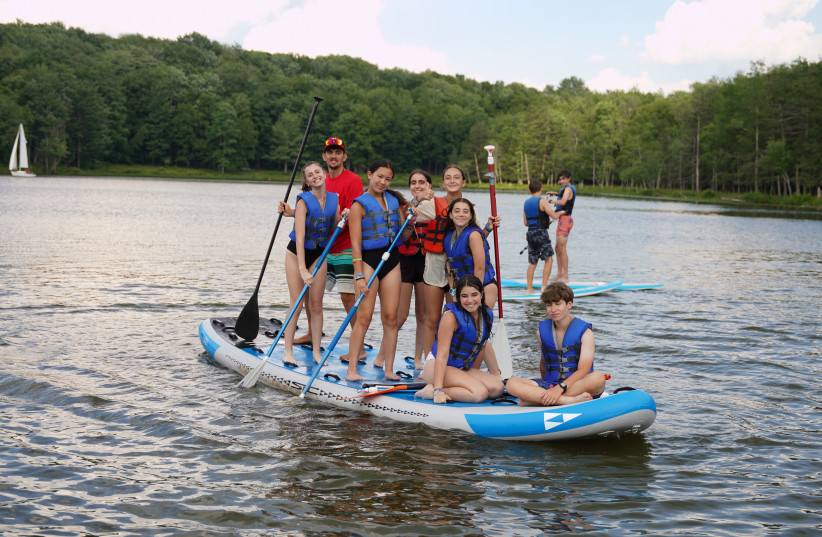As campers return to school and counselors embark on their fall semesters at college, those of us working in the Jewish camp space are taking a long exhale. After all our planning for contingencies – from security threats to Israel-related protests – none of us could have predicted just how smoothly this summer would unfold.
Amid escalation in the North with Hezbollah, let me share some much-needed good news: Based on my visits to camps, conversations with directors, and data from thousands of families and staff, I can confidently say that young Jews are doing better than you think. Still, as they transition out of camp, they’ll need extra support to once again face heightened antisemitism, divisiveness, and rancor in their backyards. Thankfully, this summer offers us valuable clues on how to provide effective support.
Jewish summer camp reminds us to let kids be kids while recognizing them as capable leaders. Young Jews need opportunities to escape nonstop news and to process it; to set aside their grief and then cry in community. In the coming year, Jewish educators, communal institutions, and families must engage in the most Jewish of tasks: insisting on joy while remaining clear-eyed about tragedy.
Back in September 2023, Jewish camp leaders like me anticipated the summer of 2024 as a turning point. Since COVID, camps had been focused on recovering from the pandemic. This summer was supposed to be the bend around the corner where things would return to normal.
October 7 plunged the Jewish camp field into a state of heartbreak, followed by a frenzy of additional planning. Every camp community was touched by the trauma of that day.
Hamas murdered four members of Upstate New York’s Camp Tel Yehudah community. They took Omer Neutra, who was connected to Ramah Day Camp in Nyack and Camp Young Judaea Sprout Lake in New York’s Hudson Valley, and Emily Damari, an alum of Camp Mountain Chai in California, hostage. More recently, Hamas murdered Hersh Goldberg-Polin, who was part of the Ramah Darom family in Georgia and participated in programming from the Cohen Camps in New England. These are just a few of countless personal connections.
For me and my colleagues across North America focused on uplifting Jewish camps, our goal became to ensure that young Jews could continue to rely on camp as a place of joy and healing. That meant bolstering security, intensifying mental health support, recruiting, educating, and supporting additional college students to serve as staff after a tough year on campus, and providing resources to deepen connections to and facilitate conversations about Israel post-October 7.
Despite our fears, no major controversies erupted at camp, and no security threats materialized. Tens of thousands of campers and staff, and thousands of Israelis – from shluchim to displaced teens – formed deep connections with their North American peers. That didn’t mean, of course, that October 7 was absent throughout the summer.
At Camp Ramah Wisconsin, which I first attended over half a century ago, campers donned bright colors and sang with smiles at this year’s Zimriyah festival, even as they dedicated songs to victims of the war. At Camp Shalom in Ontario, Canada, campers attended a local music festival on the nine-month anniversary of October 7 and reflected on the massacre at Nova.
Blending joy and tragedy
Blending joy and tragedy is a Jewish tradition during Passover, Hanukkah, and more. But never have we asked Jewish young people to weave these threads together while the tragedy is so recent, so personal, and in many ways, still unfolding. Yet, this summer, I saw and heard of tens of thousands of Jewish young people doing just that.
Sometimes, joy and tragedy coexisted in a single event, as at Camp Ramah Wisconsin or Camp Shalom. Other times, they were separate. Many camps held memorials and commemorations of October 7 and ran thoughtful Israel education programming. They also encouraged campers to have fun and enjoy activities such as dancing to Israeli songs, windsurfing, theater, or cultivating herbs from the local garden for a refreshing slushie drink on a hot day.
For some, camp was an escape from October 7, like the Israeli teens who found their first real joy in months, or the American staff member who felt the obligation to speak for Jews at her school and could finally relax among Jewish peers at camp. Others found different reasons to cherish camp. One camper who had recently undergone cancer treatment savored the normalcy of being back among friends.
Normalcy – the chance to recharge, reflect, connect with community, and celebrate their identity – is what young Jews need right now. Early survey data from this summer reveals that more than in any year in recent memory, camp created a positive impact on Jewish identity and helped young Jews feel proud to be Jewish.
Camps reported young Jews proudly wearing Star of David and Chai jewelry at a time when many Jews are hiding their identity. Parents shared that camp helped their children “live Jewishly out loud” or feel proud of their heritage after feeling marginalized at school. Survey responses from thousands of families and staff reaffirm these findings.
Camp is a thoughtfully and intentionally built community. The coming year will be more challenging. As young Jews return to school and regular life, equipped with the cell phones that they had a break from over the summer, the war in Gaza continues and the situation in the North escalates. Israeli shluchim and displaced teens who found respite at camp have returned to Hezbollah firing hundreds of rockets.
It’s now up to all of us to build on this remarkable summer by creating positive Jewish environments where young Jews can express their deepest fears, even as they sing, dance, laugh, and have fun, together.
The writer is the CEO of Foundation for Jewish Camp.

